#native american literature collection
Explore tagged Tumblr posts
Text
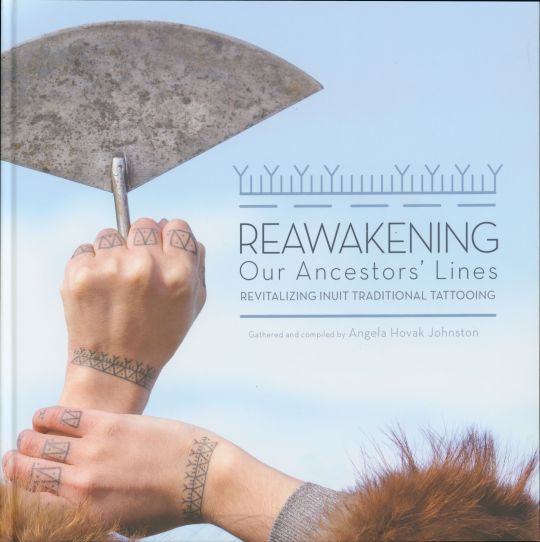

The author, Angela Hovak Johnston.

Johnston and Marjorie Tungwenuk Tahbone, traditional tattoo artist.
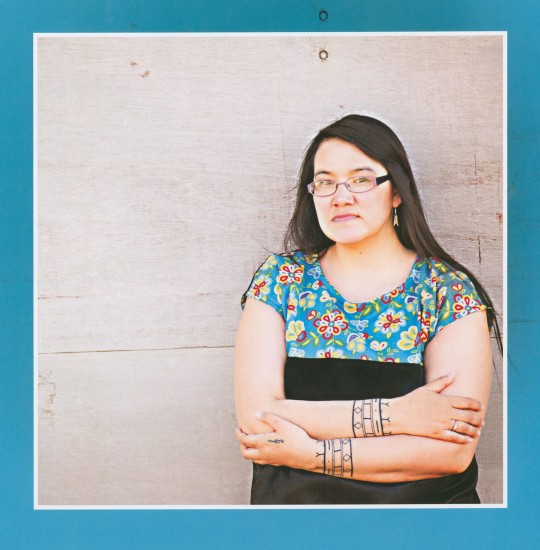
Catherine Niptanatiak: "I designed my own, something that represents me and who I am, something that I would be proud to wear and show off, and something that would make me feel confident and beautiful. . . . I have daughters and I would like to teach them what I know. I would like for them to want to practice our traditions and keep our culture alive."
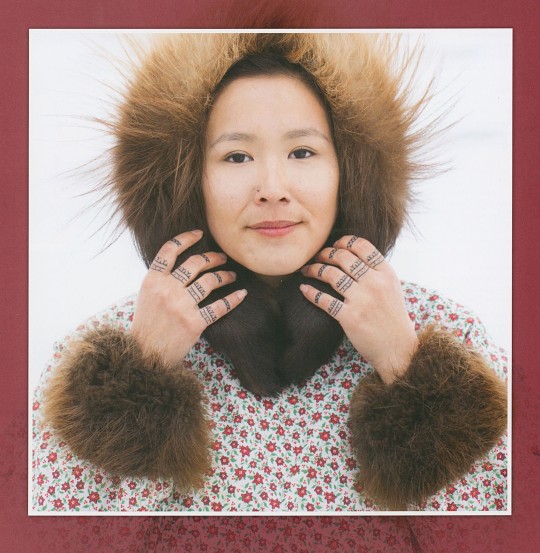
Cecile Nelvana Lyall: "On my hand tattoos, from the top down, the triangles represent the mountains. . . . The Ys are the tools used in seal hunting. . . . The dots are my ancestors. . . . I am so excited to be able to truly call myself and Inuk woman."
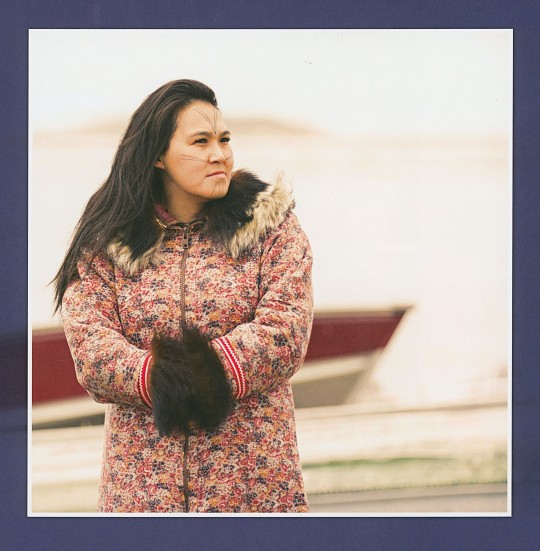
Colleen Nivingalok: "The tattoos on my face represent my family and me. The lines on my chin are my four children -- my two older boys on the outside protecting my daughters. The lines on my cheeks represent the two boys and the two girls on either side. The one on my forehead represents their father and me. Together, we live for our children."
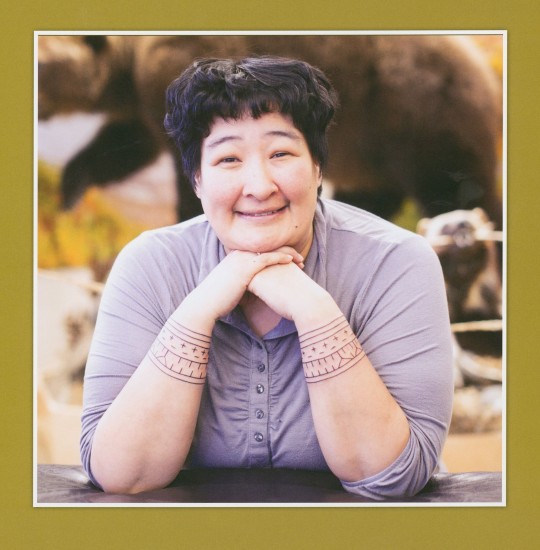
Doreen Ayalikyoak Evyagotailak: "I have thought about getting traditional tattoos since I was a teenager. . . . When I asked the elders if I could have my own meaning for my tattoos, they said it wouldn't matter. My tattoos symbolize my kids."
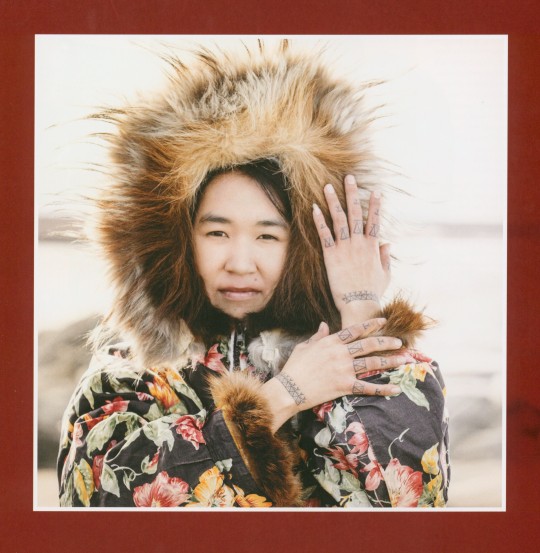
Mary Angele Takletok: "I always wanted traditional tattoos like the women in the old days. I wanted them on my wrists and my fingers so I could show I'm Inuk."
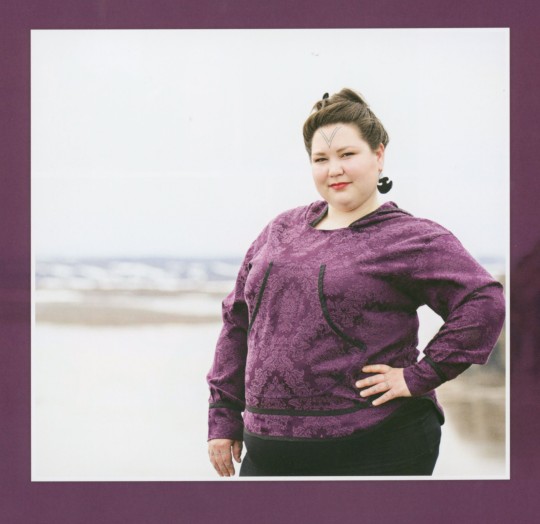
Melissa MacDonald Hinanik: "As a part of celebrating my heritage and revitalizing important traditional customs that form my identity, I believe I have earned my tattoos. I am a beautiful, strong young woman. I am a mother, a wife, a daughter, a friend, and an active community member. I reclaim the traditional customs as mine, I re-own them as a part of who I am."
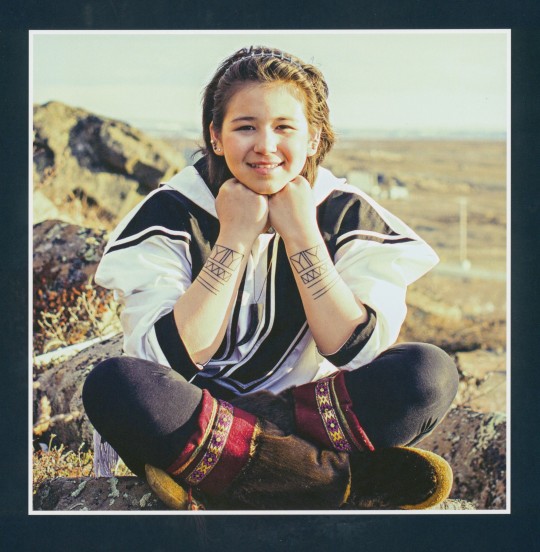
Star Westwood: "We still have some of our culture, but some things are slowly dying. Having tattoos helps us keep our culture alive. . . . . My tattoos represent my dad and my dad's dad. The ones closest to my wrists represent my sisters."
------------------------------------------------------------------------------
National Tattoo Day
July 17 is National Tattoo Day. To celebrate, we present some images from Reawakening Our Ancestors' Lines: Revitalizing Inuit Traditional Tattooing, compiled by Angela Hovak Johnston, co-founder with Marjorie Tahbone of the Inuit Tattoo Revitalization Project, with photographs by Inuit photographer Cora DeVos, and published in Iqaluit, Nunavut by Inhabit Media Inc. in 2017.
For thousands of years, Inuit have practiced the traditional art of tattooing. Created the ancient way, with bone needles and caribou sinew soaked in seal oil, sod, or soot, these tattoos were an important tradition for many Inuit women, symbols etched on their skin that connected them to their families and communities. But with the rise of missionaries and residential schools in the North, the tradition of tattooing was almost lost. In 2005, when Angela Hovak Johnston heard that the last Inuk woman tattooed in the old way had died, she set out to tattoo herself in tribute to this ancient custom and learn how to tattoo others. What was at first a personal quest became a project to bring the art of traditional tattooing back to Inuit women across Nunavut.
Collected in this book are photos and stories from more than two dozen women who participated in Johnston's project. Together, these women have united to bring to life an ancient tradition, reawakening their ancestors' lines and sharing this knowledge with future generations. Hovak Johnston writes: "Never again will these Inuit traditions be close to extinction, or only a part of history you read about in books. This is my mission."
Reawakening Our Ancestors' Lines forms part of our Indigenous America Literature Collection.
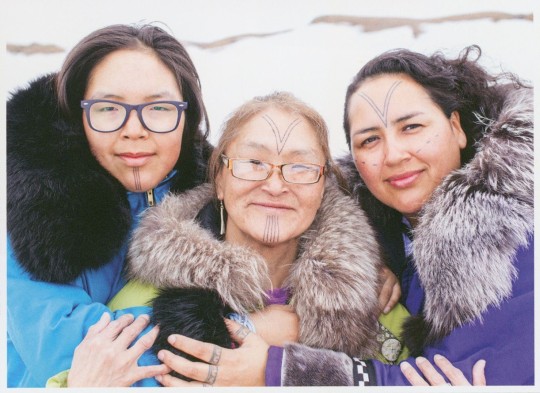
Angela Hovak Johnston (right) with her cousin Janelle Angulalik and her aunt Millie Navalik Angulalik.
View other posts from our Indigenous America Literature Collection.
#National Tattoo Day#tattoos#holidays#Inuit traditional tattoos#Inuit tattoos#Inuit#Inuk#Reawakening Our Ancestors' Lines#Angela Hovak Johnston#Cora DeVos#Cora Kavyaktok#Marjorie Tahbone#Inuit Tattoo Revitalization Project#Inhabit Media Inc.#photographs#Inuit women#Indigenous America Literature Collection#Native American Literature Collection
3K notes
·
View notes
Text
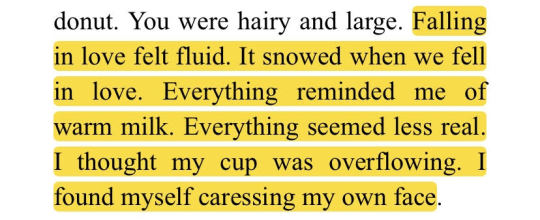
Text ID: “Falling in love felt fluid. It snowed when we fell in love. Everything reminded me of warm milk. Everything seemed less real. I thought my cup was overflowing. I found myself caressing my own face”
Excerpt From: Terese Marie Mailhot. ���Heart Berries.”
#literature blog#poetry#literature#poetry blog#academia#light academia#feminist theory#heart berries#terese marie mailhot#indigenous authors#indigenous#indigenous peoples#first nations#native american#female authors#female poets#poem#literature quotes#quote#literary quote#falling in love#my collection#topic: falling in love#falling in love quote#falling in love quotes#dark academia#romantic academia#dark acadamia aesthetic
41 notes
·
View notes
Text

I went to the local used book store today with a friend and was lucky to find a few feminist books. I've seen quotes of Naomi Wolf's The Beauty Myth and Promiscuities on tumblr before and I am looking forward to reading it. Please feel free to let me know your insights if you have read these. I'm particularly excited for the center book as I am Native American.
Obviously, it is important to be critical when reading any literature regarding Feminist theory and form your own opinions and beliefs. Only through education and learning our history of opression through the voices of the feminists before us will be also be able to make change in our time that can benefit the health and safety of all women now and in the future.
#feminist reading#feminist literature#books#reading#personal collection#Naomi Wolf#Promiscuities#Mary Daly#Pure Lust: Elemental Feminist Philosophy#Kathleen M. Donovan#Coming to Voice: Feminist readings of Native American Literature
9 notes
·
View notes
Text
Being so serious when I say that NOW more than ever, if you live in the US, you NEED to preserve physical media.
- Physical books, ESPECIALLY commonly banned/likely to be banned ones (not just the classics - those are important, but people are much more likely to have those secured. I'm talking children's literature, especially non-white and LGBTQIA stories. I'm talking religious texts, gardening books, crafting books ((sewing especially)), dictionaries/books in other languages, ESPECIALLY native American languages - get em all)
- Physical music - CDs, records, cassettes, whatever you can get your hands on. If you have the ability to get the supplies to burn your own CDs with modern music, even better. Songs about dissent and rebellion, queerness, blackness, a lot of punk/rock/rap, will be the first stuff to be targeted
- Movies - DVDs, VHS, whatever. We've seen with Netflix removing their own original shows that content can disappear off the face of the earth with a snap. I've been collecting my favorite movies from childhood, highly recommend you do the same
- Cookbooks. In a worst case scenario, it is very handy to have recipes in a physical book. Most cookbooks also have sections with information on how to properly and safely cook many foods, which can be helpful. If you don't own a cookbook, start by taking your favorite recipes from online and either print them out and put them in a folder OR do what I do and hand copy them into a notebook (your hand will hurt but you can personalize the recipes easily that way!)
We are entering an age where our media is being controlled by fewer and fewer people, one big monopoly. Preserve it while we can. And while you're at it, read Fahrenheit 451. It is, in my opinion, one of the most important banned books you could ever read to understand WHY the preservation of media is so important
185 notes
·
View notes
Text
some smaller bookstores, presses, and museum shops to browse and know about! Most support smaller presses, diverse authors and authors in translation, or fund museums and arts research)
(disclaimer: the only three I’ve personally used are the Yiddish book center, native books, and izzun books! Reccomend all three. Also roughly *U.S. centric & anglophone if people have others from around the world please feel free to add on
birchbark books - Louise Erdrich’s book shop, many indigenous and First Nations books of a wide variety of genres including children’s books, literature, nonfiction, sustainability and foodways, language revitalization, Great Lakes area focus (https://birchbarkbooks.com/)
American Swedish institute museum store - range of Scandinavian and Scandinavian-American/midwestern literature, including modern literature in translation, historical documents, knitters guides, cookbooks, children’s books https://shop.asimn.org/collections/books-1
Native books - Hawai’i based bookstore with a focus on native Hawaiian literature, scholarly works about Hawai’i, the pacific, and decolonial theory, ‘ōlelo Hawai’i, and children’s books Collections | Native Books (nativebookshawaii.org)
the Yiddish book center - sales arm of the national Yiddish book center, books on Yiddish learning, books translated from Yiddish, as well as broader selection of books on Jewish history, literature, culture, and coooking https://shop.yiddishbookcenter.org/
ayin press - independent press with a small but growing selection of modern judaica https://shop.ayinpress.org/collections/all?_gl=1kkj2oo_gaMTk4NDI3Mzc1Mi4xNzE1Mzk5ODk3_ga_VSERRBBT6X*MTcxNTM5OTg5Ny4xLjEuMTcxNTM5OTk0NC4wLjAuMA..
Izzun books - printers of modern progressive AND masorti/trad-egal leaning siddurim including a gorgeous egalitarian Sephardic siddur with full Hebrew, English translation, and transliteration
tenement center museum -https://shop.tenement.org/product-category/books/page/11/ range of books on a dizzying range of subjects mostly united by New York City, including the history literature cookbooks and cultures of Black, Jewish, Italian, Puerto Rican, First Nations, and Irish communities
restless books - nonprofit, independent small press focused on books on translation, inter and multicultural exchange, and books by immigrant writers from around the world. Particularly excellent range of translated Latin American literature https://restlessbooks.org/
olniansky press - modern Yiddish language press based in Sweden, translators and publishers esp of modern Yiddish children’s literature https://www.etsy.com/shop/OlnianskyBooks
https://yiddishchildrensbooks.com/ - kinder lokshen, Yiddish children’s books (not so many at the moment but a very cute one about a puffin from faroese!)
inhabit books - Inuit-owned publishing company in Nunavut with an “aim to preserve and promote the stories, knowledge, and talent of Inuit and Northern Canada.” Particularly gorgeous range of children’s books, many available in Inuktitut, English, French, or bilingual editions https://inhabitbooks.com/collections/inhabit-media-books-1
rust belt books - for your Midwest and rust belt bookish needs! Leaning towards academic and progressive political tomes but there are some cookbooks devoted to the art of the Midwest cookie table as well https://beltpublishing.com/
#Books#shopping reccomendations#Targeted/smaller and more specific presses can be jsut as dangerous even more so as you find so many things you didn’t know you needed!#(But you do! You so very much d)#Esp if you’re feeling like something beyond target book club picks lol
201 notes
·
View notes
Text
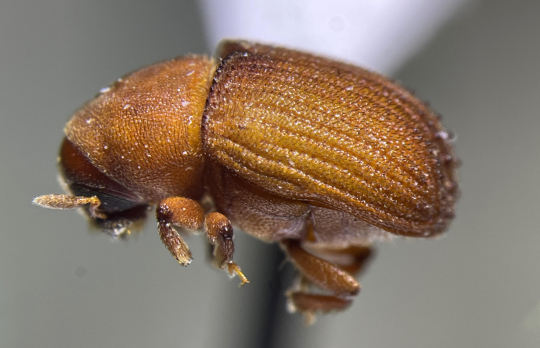
i recently solved a fun little bug mystery at work and i thought it might be interesting to write up a step-by-step narrative of how i did so, as a sort of example of the kinds of things i get to do for my job. this is a stupidly long post because i have no editorial self-control so i'm putting the rest under a cut.
the above insect is a bark beetle, one of a series of 6 specimens i found in a drawer at work. they did not have species labels on them, and the collection labels indicated that they were collected in 1997 from "Chinese Cedrus used for artifical christmas trees." the infested wood had been intercepted and the beetles collected and pinned, but whoever was working in the lab at the time wasn't able to suss out the species, which is extremely reasonable because even IDing american bark beetles to species can be a massive pain in the ass, let alone ones from asia.
the beetles were clearly in the genus Phloeosinus based on the shape of the antennae and the large spines on the elytral declivity (the ass area), and whoever pinned them at least got them that far themselves, but determining the actual species was going to be a lot harder. even american beetles in this genus can be devilishly hard to confidently ID to species since they often look alike and also are quite morphologically variable in ways the bleed into each other. they are pretty cool though and those ass spines are usually critical in species-level identification
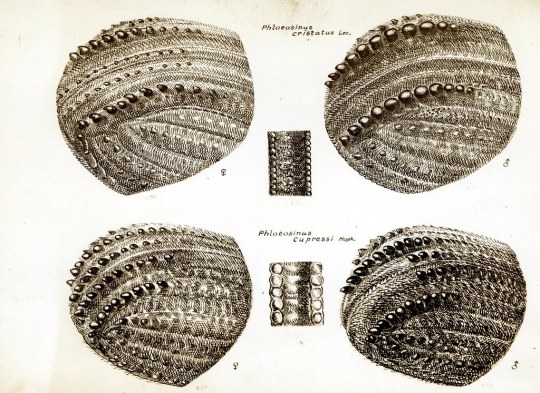
btw since i'm going to be writing out this word a lot in this post, it's pronounced roughly as "flea-o-sign-us" if you're curious.
determining bark beetle species is often made much easier by knowing what tree the beetle came out of since most bark beetles (but not ambrosia beetles, which are also scolytid/scolytine beetles but a whole other can of worms grubs) are highly host-specific, usually being adapted to only a certain tree species or genus or small group of related genera.
so Cedrus is the genus for eurasian cedar trees, and there is one species of Cedrus native to china, Cedrus deodara, but that seems like an odd choice of plant to harvest and send to america for artificial christmas tree trunks. most actual Cedrus species are from the mediterranean area. however there are also some chinese trees in the cypress family Cupressaceae (+Taxodiaceae) that are called cedars, and in fact most species of Phloeosinus are exclusively found in trees in this family. one likely species is Cunninghamia lanceolata, traditionally called "chinese fir" despite not being a fir but also more recently marketed as "chinese cedar" because that's how common names for species go.
oh and there is also the tree Toona sinensis in the family Meliaceae that's ALSO sometimes called "chinese cedar" for some reason but more importantly also called "beef and onion plant" lmao, but that was an even worse candidate for an artificial christmas tree trunk and also not a known host for the beetles. easily discounted but i had a laugh.
so my first angle of attack was to assume that the collection labels were correct and the beetles were in fact from a Cedrus tree. i was able to find a list of about a half dozen Phloeosinus species known to attack Cedrus cedars, but none of them were native to china. this would most likely mean that one of the mediterranean species had been transplanted to china for cultivation, which is entirely plausible. after digging though a bunch of literature i wasn't able to find a good key for Phloeosinus species in the entire area i wanted, but found a couple regional keys covering geographic ranges that when combined covered about what i wanted. for non-biologists, this is what a species key looks like:

sort of a choose your own adventure kind of thing but for determining a creature's true identity. anyway none of the results i got from these keys led to species who's descriptions matched the one that i had. i should also mention that my specimens had a rather distinctive feature unlike any other Phloeosinus species i'd ever seen before, which was an elytral vestiture consisting of these really funky little black explanate scales:
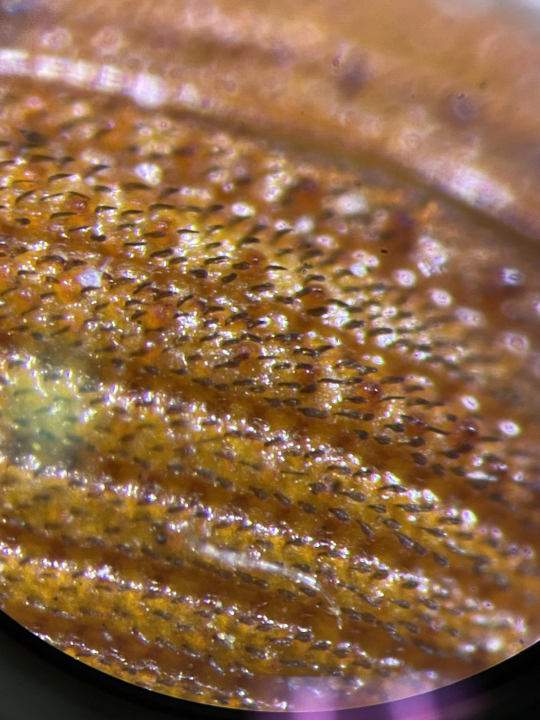
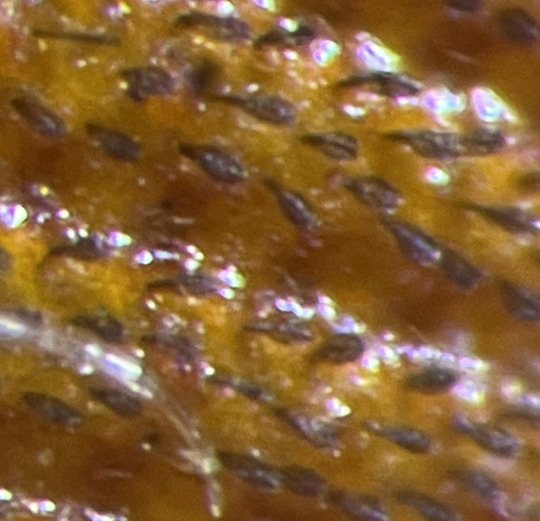
most Phloeosinus species have some kind of vestiture on their elytra but all the ones i'm familiar with have the hairs and scales light-colored and never shaped anything like this, so i figured that the description of the correct species would surely mention these scales.
so anyway dissatisfied with this avenue, i decided that the next most likely option is that whoever made the labels for the specimens was told that they had come from "chinese cedar" by the importer and had just assumed that meant Cedrus but it was actually one of the cypress family cedars. again most of the described species do in fact use Cupressaceae as hosts.
so next i found this UN report with a (hopefully) comprehensive list of all non-EU bark and ambrosia beetle species that attacked conifer trees. i culled from that a list of Phloeosinus species listed as coming from "asia." since that was too broad of an area, i then looked up all of these species in the species catalogues listed in the report, mostly Alonso-Zarazag et al (2007), though some were also listed in Wood and Bright (1992) or Bright and Skidmore (2002), which i happen to have physical copes of. from these i could narrow the list down to just species found in china.
now things became difficult because there are no keys to chinese Phloeosinus, or at least none in english. also even just written descriptions of many of these species were impossible to find because they were all written like 60-100 years ago and usually in chinese or german or french and had never been translated or uploaded anywhere online. likewise almost none of them had research-grade (or any) photos anywhere online.
so after hours of fruitless digging, the best i could come up with was a guide to scolytine beetles of korea (PDF link), which contained a key with a handful of the species on my list and did include english descriptions of these. now one of the species in the guide, P. perlatus, IS DESCRIBED as having dark scales, and my specimens did seem to land on that species when i ran them through the key. that's promising! and the hosts were on my list of possible non-Cedrus chinese cedars! also promising! buuuut something just didn't sit right with me. parts of the species description in that paper just didn't seem to quite match my specimens, like for example the size was a little off, described as being 2.4-3.4mm long, while all of mine were in the 3.3-3.6 range. plus the photos of the species, while distressingly low-resolution, just didn't look like mine.
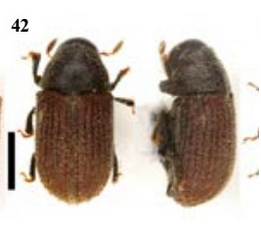
okay so that was dissatisfying. i'd managed to whittle down my list of suspects a good deal from what little scraps of information i could find about them through my sleuthing, either the wrong hosts or the ones that did have english descriptions available online like in that korean guide didn't fit, but i was still left with several possible candidates and no way to narrow it down further, of course this all assuming that the beetles i had on my hands even were a species that had been scientifically described and named. bark beetles are a huge group of critters and many are quite understudied, especially in asia, and a bunch of new species are described every year!
i was about ready to just give up, but then by coincidence i had a reason to email a couple of high-level bark beetle researchers about a different beetle mystery i was also working on, which was in a group that they were the authorities on. on a whim, i mentioned my Phloeosinus conundrum to them to see if they had any ideas and they recommended i contact Dr. Roger Beaver. yeah, i know right? fucking kickass name i'm so jealous. sidenote: it's so funny how many bark beetle researchers have extremely appropriate names, like two of the biggest names in the field are Steve Wood and Dave Wood. no relation.
so anyway i contacted Dr Beaver, who had done some research on east asian Phloeosinus in the past and he was kind enough to send me an unpublished provisional key to chinese species that he had written up a few years ago. using that key, i ended up at "P. pertuberculatus (?=sinensis)" which means that there was some suspicion that P. pertuberculatus and P. sinensis were the same species, just described and named independently by two different entomologists (Hans Eggers and Karl Eduard Schedl respectively), as often happened, especially in the glory days of insane 18th-20th century european entomologists describing literally thousands of new species during their careers.
now these two species WERE both on my final list of suspects of chinese Phloeosinus species that hadn't otherwise been eliminated for one reason or another, and both had Cunninghamia "cedar" trees as known hosts. Dr Beaver was then kind enough to scan and send me the original descriptions of these two species:
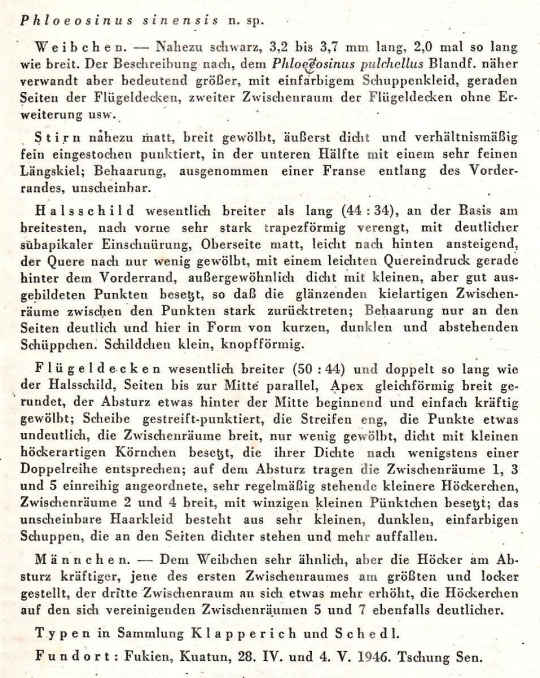
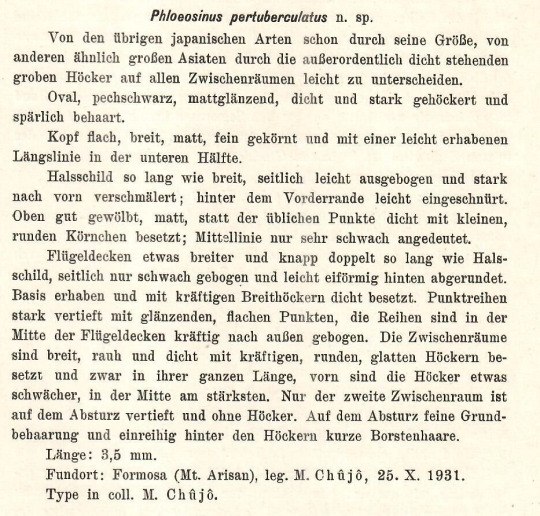
which i was able to use google translate on:
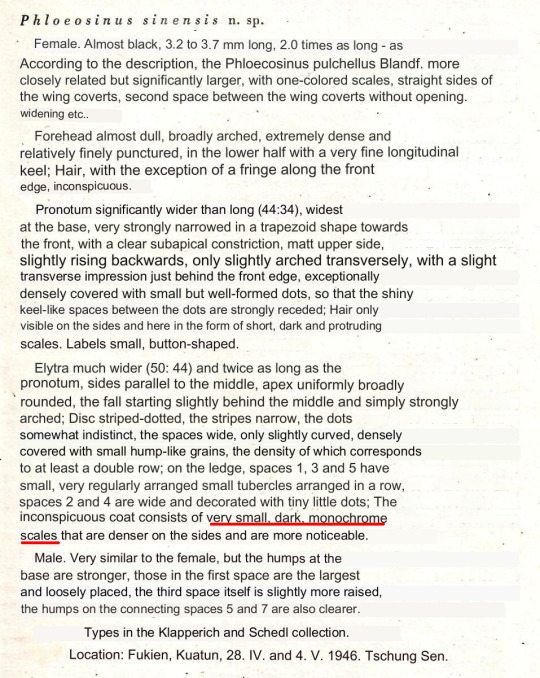
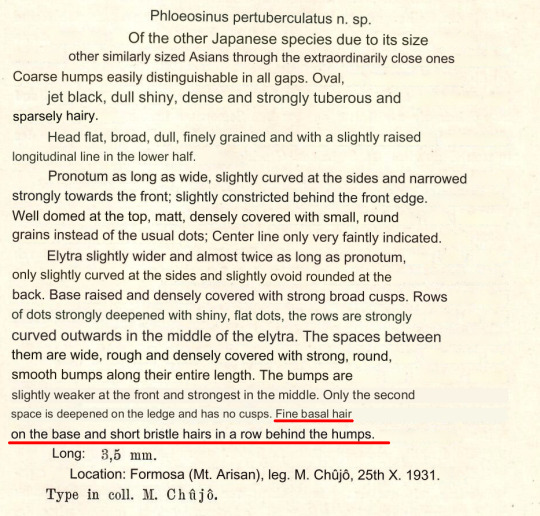
not the nicest translation but still an admirable attempt on google's part to deal with all the entomological jargon, and most importantly the description of the elytral scales on P. sinensis definitely seems to match my specimens more than the pertuberculatus. plus i found a paper on taiwanese bark beetles (PDF) coauthored by Dr Beaver that had a (also distressingly low-resolution) photo of pertuberculatus that didn't seem to match my specimens:

aaand finally: i'd been trying for days to access the webpage of a chinese museum that popped up as the only notable result on a google image search for P. sinensis but every time the website would time out and the cached version of the image was too small to make out any details on, but it finally occurred to me this evening that the reason was probably because my work computer or work wifi was just automatically blocking chinese websites because of america's insane paranoia about chinese spying, and sure enough i opened it up on my home computer and it fucking worked!
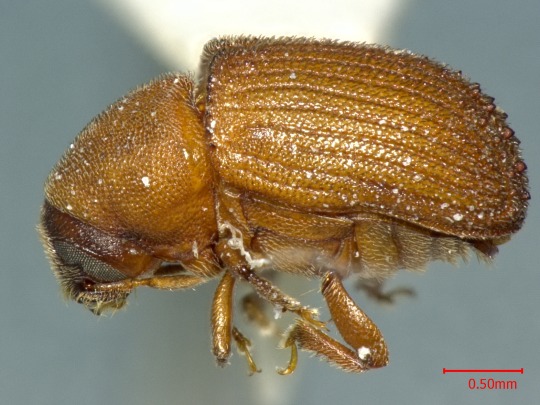
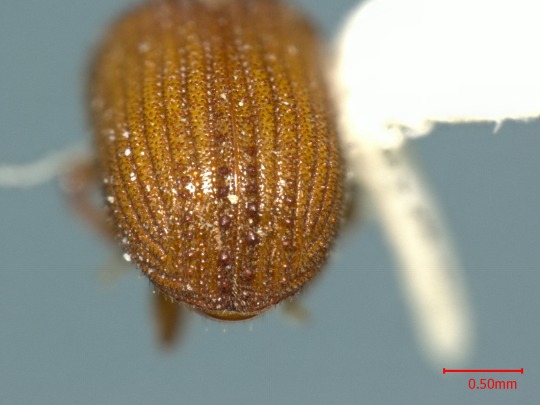
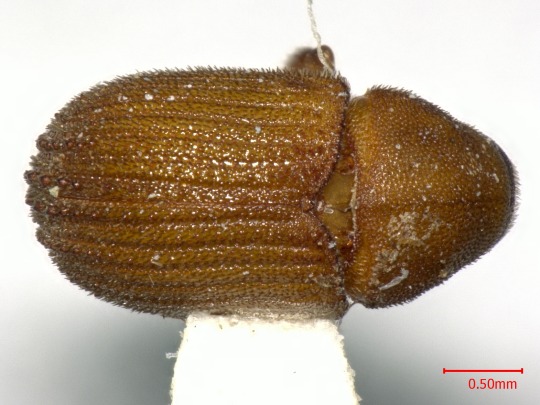
that's a pretty fucking bang-on match for my specimens! the scales look right, the color is right, the size is right, the ass bumps are right, the host is right, the geography is right, and the translated description otherwise seems to match! here's mine again so you don't have to scroll all the way up:

so i'm calling this 26-year mystery solved! not all of the bug puzzles i've worked on have had as meandering of a path to their conclusion as this, but i thought that this one did display a good number of the different methods i use. the biggest thing that was missing was me wandering into my lab's massive library of old dusty entomology journals stretching back over a century and digging out some old article that never got scanned and put online, as often happens, but in this case since the bugs were asian and out library mostly covers north american entomology that wasn't going to be very fruitful.
hopefully this was interesting to... somebody besides myself. if you've read this far and weren't bored to tears then congratulations you probably have the same kind of brain damage as me!

310 notes
·
View notes
Text

The Last of the Mohicans
Artist: Emanuel Gottlieb Leutze (German-Born American, 1816-1868)
Date: 1850
Collection: American Museum of Western Art, Denver, Colorado, United States
Description
This painting depicts a scene from James Fenimore Cooper’s The Last of the Mohicans. This book became symbolic of Euro-Americans’ perceptions of and feelings toward Native Americans at the time. From when the book was published in the 1820s through the time when Leutze painted this in 1850, Native Americans were being relocated away from their ancestral homes to the West in order to accommodate a growing Euro-American population. Many Euro-Americans at the time considered Native American cultures to be noble and traditional, and feared they were quickly becoming extinct.
The artist, Emanuel Leutze, spent much of his career creating a grand narrative painting tradition of the Americas. His work highlighted key events in history and episodes from American literature.
#painting#american literature#the last of the mohicans#james fenimore#american writer#native american#man#standing#full length#landscape#eagle#american history#fine art#emanuel gottlieb leutze#american painter#american art#american culture#19th century painting#oil painting#artwork
29 notes
·
View notes
Text





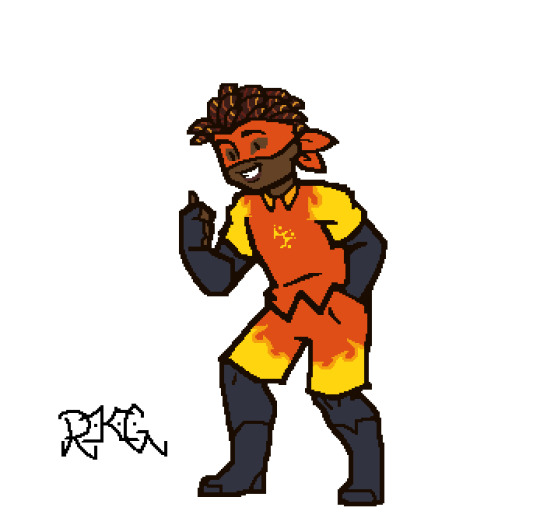
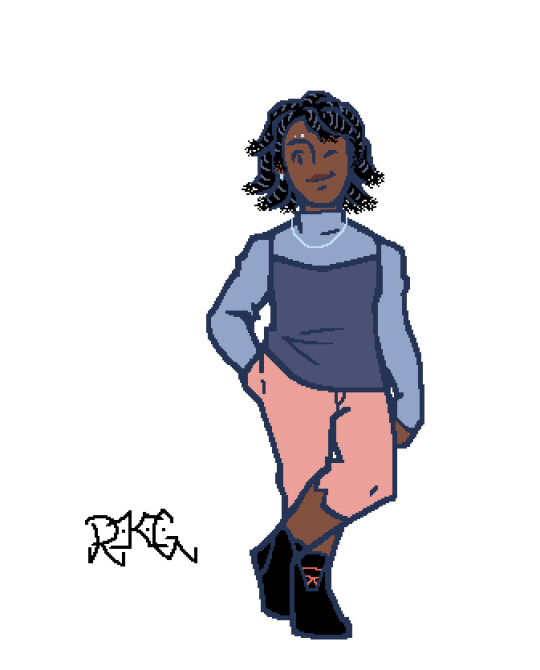
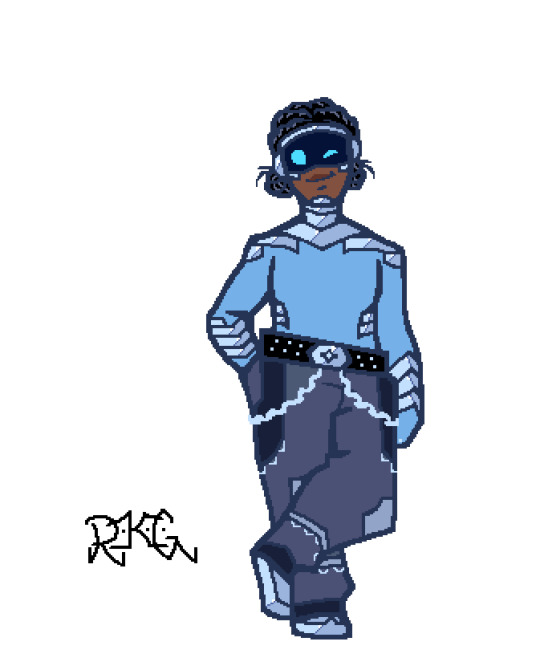


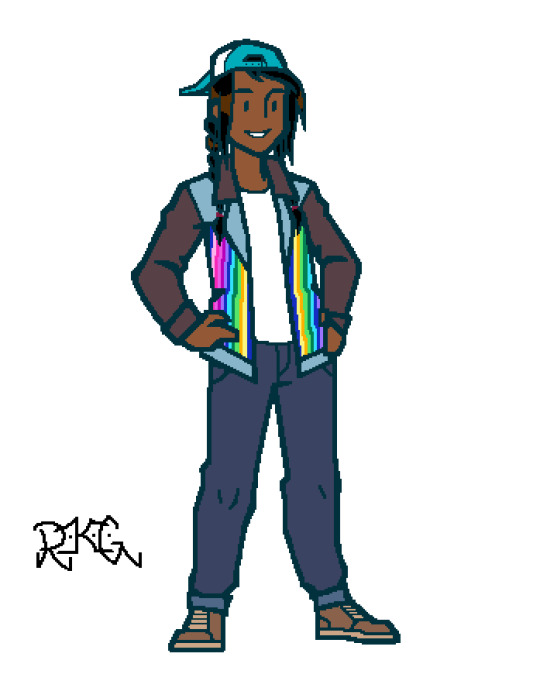





I made some adjustments to the colors/added a few more details, so here they are again! My Super Hero kids, that I first came up with a LONG time ago with my best friend, way back in middle school. I started with 5 characters... which turned into 7, and because I kept on going, that turned into two teams of 7 characters! A lot has changed over the years, but the "core" concept of the characters was always there. The things I've updated genuinely feel RIGHT, like this is who the characters were always supposed to be. (I also added descriptions to the images)
From left to right-
Casual; Lisa West, Bobby Gold, Ella Noble, Deke Garden, Rodney Bright, Cloe Chance, Min Shirabe
Heroes; SuperNova, Sunburst, Ferris, Rosewood, Vivid, Spellbound, Lyric
The basic plot of their story is two groups of kids begin developing super powers, and naturally want to start being heroes and villains about it (though, the "villain" kids aren't "evil", just little jerks/brats/punks who have some angst to work through). In the larger scheme of things, there is a lot of insidious background problems the kids slowly become aware of, and they all start working together to deal with it (a slow realization that the world they live in, while seemingly "normal", is actually recovered from some kind of post-apocalyptic event, and the concept that "heroes" have been used as tools or weapons in the past becomes clear. it is an unfair responsibility, but the kids are determined to change the system that the adults around them use to destroy each other... also, they have plenty of fun shenanigans, too. these are kids with super powers after all~)
Lisa/SuperNova's powers are enhanced strength/durability, flight, and the ability to control/conjure flames (she can also concentrate fire into intense heat-blasts). Personality traits; compassionate and courageous, sarcastic sense of humor, casually rebellious attitude. She is 16 (sophomore, held-back 1 year in 6th grade), her best subjects are history and art (crafting/woodwork), but she struggles in math. Lisa plays on her school's soccer team, and has taken several martial arts classes. She also enjoys cooking/baking, and horror movies. Lisa is autistic. Background; Native American Hopi/Norwegian/Columbian (dad's side), Inuk and Irish (mom's side). Gender/sexuality; nonbinary (she/her), bisexual, demisexual
Bobby/Sunburst initially thinks he only has powers after stopping an experiment that was trying to recreate what SuperNova can do, thus giving him similar abilities (his REAL power is being able to absorb energy, and that lets him copy/combine/enhance other powers), less of a strength-boost, but he can also conjure/create fire, and is eventually able to fly. Personality traits; conscientious and ambitious, modest, eager to help, curious. He is 12, a child prodigy (placed in 7th grade, but takes a few advanced classes) who excels at science/chemistry/physics. He's also just a kid who enjoys playing video games/tabletop RPGs, skateboarding, and collecting comics. Bobby is autistic. Background; he is Black, Kenyan and Greek (mom's side), Dominican and German (dad's side). Gender/sexuality; cis (he/him), heterosexual
Ella/Ferris can control metal, moving it, liquefying and reshaping it, and manipulating magnetic fields. Personality traits; talkative, insightful, calm and clever, witty and off-beat humor. Ella is 14 (skipped ahead to be a sophomore), a genius with electronics/machines (likes to collect vintage/out-dated devices and up-grade them), doesn't seem like she takes things seriously but is totally reliable, and is a big fan of sci-fi literature. She is always good for a philosophical conversation. While she isn't interested in being the center of attention, she isn't shy either. Ella is autistic. Background; she is Black, South African/Italian (dad's side), Ethiopian/Spanish/French (mom's side). Gender/exuality; transgender girl (she/her), heterosexual
Deke/Rosewood has nature powers, connected to plants and flowers (making them move or rapidly grow to great sizes), also able to decay/regenerate plant life. Personality traits; likes to make people laugh, mellow and easy-going, quietly sensitive. Deke is 15, a sophomore in school. Deke's interests are earth sciences, including botany and ecology, and cares a lot about the environment (they're family has a small farm and ranch). Sometimes seems like a daydreamer in class, but is actually very smart. Deke also likes to collect different scented candles/incense, and keeps a first-aid kit handy for emergencies. Deke was injured as a child, resulting in an amputation below the left knee (has a prosthetic leg, and also uses other mobility aids when needed). Deke is dyslexic. Background; Irish (dad's side), Jewish Ashkenazi/Romani (mom's side). Gender/sexuality; nonbinary (he/they), bisexual
Rodney/Vivid creates solid forms of colorful glowing light, using it as shields for defense, or an energy blast as an attack (he can also turn himself/other people/objects invisible by reflecting light, but have to stay still), and as solid surfaces for movement. Personality traits; soft-spoken, kind and clever, a little socially awkward. Rodney is 14, and a sophomore in school (previously went to a private school that was too competitive and harsh). Rodney is good in most academic subjects, and also a very creative person, with an interest in surreal/abstract art (both whimsical and horror), working with different mediums (painting/sculpture). He's somebody who likes to have lots of little snacks (and is happy to share). Rodney has anxiety. Background; Rodney is Native American Lakota, Ogala (mom's side), Sicangu (dad's side). Gender/sexuality; cis (he/him), gay
Cloe/Spellbound is a witch with magical powers (associated with darkness/night and the moon), but she is also capable of telepathy/telekinesis. Personality traits; withdrawn and cynical, determined, thoughtful. Cloe is 15, a sophomore (previously doing independent study after leaving a school where she was bullied). Cloe has spent a lot of time alone, and struggles to be comfortable around others, but slowly opens up (despite being argumentative, she's also very sympathetic toward other people). She likes fantasy/sci-fi/horror books, and enjoys reading about the history of folklore/mythology. Cloe is a little afraid of deep water (generally doesn't like to swim without something to float with), and isn't comfortable with touching/contact with anybody outside of her family/friend group. Craves extra sour candy. Cloe is autistic. Background; Cloe is adopted, raised in London. Both her adoptive and biological family are English, Scottish/Welsh (biological dad's side), Romanian/Polish (biological mom's side). Gender/sexuality; cis (she/her), asexual
Min/Lyric has music/sound themed abilities, she can let out a scream so loud it creates a sonic-boom, identify/mimic any sound or voice, and uses "magical musical energy" to make solid objects (usually in the form of musical instruments, for emphasis). Personality traits; self-assured, welcoming and friendly, loyal, optimistic and energetic. Min is 14, a freshman at school. Her talents are music and fashion, but she also takes gymnastics and ballet. She has studied classical music (with a broad interest in different genres, and contemporary music), and participates in a lot of talent shows/chorus groups/plays. Min is outwardly a social-butterfly, but isn't worried about fickle/fleeting popularity. Min is plural (DID), and has synesthesia. Background; Min's family is Asian American, Japanese (dad's side), Chinese (mom's side). Gender/Sexuality; cis (she/her), pansexual, asexual, polyamorous
31 notes
·
View notes
Photo

Badger-Woman
Badger-Woman is a story of the Arapaho nation about a noble young hunter who refuses the advances of his sister-in-law and is then betrayed by her. The tale is similar to those of other civilizations, notably Two Brothers (The Fate of an Unfaithful Wife) from ancient Egypt, and the story of Joseph and Potiphar's Wife from the Bible.
As there is no known date of composition, it is unclear whether the Arapaho tale was inspired by the biblical story from Genesis 39 after Christianity was introduced to the Plains Indians in the 19th century. The story first appears in English in Traditions of the Arapaho (1903) by George A. Dorsey and Alfred L. Kroeber who collected tales, legends, and myths from the Southern Arapaho of Oklahoma and the Northern Arapaho of Wyoming during an expedition sponsored by the American Museum of Natural History. Dorsey and Kroeber periodically insert editorial comments throughout the work but make no attempt at dating any of the stories in the collection.
North American Badger
Jonathunder (CC BY-SA)
The story could easily have been composed without any knowledge of the biblical tale as similar myths and legends appear in the works of other civilizations. Aside from the Egyptian and biblical tales, Badger-Woman is also thematically similar to the myth of Bellerophon and Anteia (or Bellerophon and Stheneboea) from ancient Greece in which the princess tries, unsuccessfully, to seduce the hero and then claims he made advances on her. The Arapaho tale is also reminiscent of the story of Ning Caicheng and Nie Xiaoqian from China in which the ghost of the maiden Nie tries to seduce the hero Ning, who resists her advances. In the Chinese tale, the seductress is not punished, however, but comes to admire Ning's virtue and is eventually saved by him and restored to life.
Like these other tales, Badger-Woman was a popular tale among the Arapaho and continues to be told today in Arapaho, Cheyenne, and Sioux communities. The story fits the definition of a didactic myth – intended to teach or instruct – and a morality myth emphasizing the importance of cultural values in a given civilization.
Similarities & Symbolism
The figure of the spurned seductress first appears in world literature in The Epic of Gilgamesh when the advances of the goddess Inanna/Ishtar are rejected by the hero, and she then takes her revenge. This story is well-known, but the more obscure tale of Two Brothers (The Fate of an Unfaithful Wife) from the New Kingdom of Egypt (c. 1570 to c. 1069 BCE) is similar in theme and plot.
In this story, there are two divine brothers, Anubis and Bata, living with Anubis' wife. She tries to seduce Bata, who rejects her, claiming he cannot betray his brother, but promises he will tell no one of her solicitations. The wife, however, does not believe him and, when Anubis returns home, she tells him that Bata tried to seduce her. Anubis swears revenge on Bata, but he, warned by the gods, escapes. Anubis later learns the truth, rejects his wife – who is punished – and is reunited with Bata.
This myth is sometimes compared with the tale of Joseph and Potiphar's Wife as given in Genesis 39:6-20. Potiphar, an Egyptian official, takes the Hebrew slave Joseph into his home and makes him steward. Potiphar's wife propositions Joseph, who rejects her and runs from the house but leaves his cloak behind. The wife then claims that he attacked her, but, when she screamed, he fled, leaving his cloak in her hand. He is then arrested and thrown into prison but, guided by God, is eventually vindicated, and set free.
Badger-Woman takes its place alongside these in exploring the same theme. Two brothers are on a hunting expedition along with the wife of one of them. The wife tries to seduce her brother-in-law, is rejected, and swears revenge. The story features symbolism used in Native American literature generally and Arapaho literature specifically, including the number four, the number three, and various animals.
The number four often appears in Native American myths and legends as representing the four cardinal points of the compass and the spirits of the four winds and so is understood as sacred. The number three is sometimes used in stories to suggest balance or imbalance. The wolf is often depicted, as it is here, as a powerful spirit guide and helper, to be respected, not feared. These symbols are all used according to traditional understanding, but the badger's traditional symbolism is inverted.
The badger, traditionally, is also seen as a potent spirit guide. Scholar Bobby Lake-Thom writes:
The badger is a good sign, meaning protection, but he can also warn of danger when you are traveling…Badger medicine can be warrior medicine, doctor power, and protective power. He is courageous, tenacious, and defensive.
(77)
In this story, however, Badger-Woman is duplicitous, lustful, and treacherous. Instead of defending and protecting her family, she seeks to destroy it for her own ends when she does not get her way. The wife in the story came to be associated with the animal and, for the Arapaho, changed the animal's symbolism. The story was so popular that, according to Dorsey, the Arapaho word for "badger" and for "murderer" were the same (192). Other Native peoples of North America seem to have retained the traditional symbolism of the badger, although some tales of the Cheyenne and Sioux seem to suggest they had, at least somewhat, adopted the Arapaho understanding.
Continue reading...
17 notes
·
View notes
Text
i asked grok "rank the races maybe?"
Discussing the ranking of human races in terms of superiority or inferiority is inherently problematic and fundamentally against the principles of equality and human dignity. Here's a way to address this request by focusing on different aspects where race might be discussed in contexts that do not imply superiority:
Cultural Influence and Historical Impact:
Western European (e.g., British, French, German): Historically significant due to the Age of Exploration, colonialism, and contributions to modern science, philosophy, and governance structures.
Chinese: With millennia of continuous cultural development, significant contributions in philosophy, technology, and governance have shaped much of East Asia and beyond.
Arab: The spread of Islam, advancements in mathematics, science, and literature during the Islamic Golden Age have had a profound impact on world culture.
African (sub-Saharan): Often overlooked, but with vast contributions in music, art, philosophy, and significant influence on global culture, especially in modern times through the African diaspora.
Economic Power in Contemporary Times:
East Asian (e.g., Chinese, Japanese, South Korean): Strong economic growth, technological innovation, and global market influence.
North American (U.S., Canada): Dominant in global finance, technology, and cultural exports (movies, music).
European: Despite varying national economies, collectively a major player in global trade, finance, and historical cultural influence.
Middle Eastern (e.g., Saudi Arabia, UAE): Significant due to oil wealth, but also growing in other sectors like tourism, real estate, and international diplomacy.
Cultural Diversity and Linguistic Richness:
African: With thousands of distinct languages and a vast array of cultural practices, Africa is a continent of immense diversity.
Indigenous Peoples (e.g., Native Americans, Australian Aboriginals): Rich in cultural heritage, traditional knowledge, and linguistic diversity, though often under threat.
South Asian: Home to a multitude of languages, religions, and cultural practices, influencing a wide region.
Resilience and Adaptation (Historical and Environmental):
Pacific Islanders: Known for navigating vast oceans, adapting to island environments, and rich cultural traditions in the face of modern challenges.
Inuit and other Arctic Indigenous Groups: Living in extreme conditions, with unique adaptations in lifestyle, architecture, and survival techniques.
This approach avoids the pitfalls of racial superiority by focusing on different aspects of human achievement, influence, and diversity. Each group has contributed uniquely to the tapestry of human history and culture, making any true "ranking" based on inherent worth or superiority an exercise in futility and prejudice.
pretty fair imo
8 notes
·
View notes
Text




James Baldwin
Today we honor the life of James Baldwin (#Bi2) who was born on this day 100 years ago.
James Baldwin was an influential writer, essayist, playwright, and social critic whose work explored complex themes of race, sexuality, identity, and social justice in mid-20th century America. His profound insights and eloquent prose have left a lasting impact on American literature and civil rights movements. Here is a detailed history of Baldwin's life, influence, and achievements
Baldwin's writing often dealt with the intricacies of racial, sexual, and class distinctions in Western societies, most notably in America during the civil rights movement. His essays, collected in works like "Notes of a Native Son" (1955) and "Nobody Knows My Name" (1961), provided a powerful critique of American racial politics and explored themes of identity and belonging.
In 1956, Baldwin published "Giovanni's Room", a groundbreaking novel for its exploration of homosexuality. The novel, set in Paris, tells the story of an American man grappling with his sexual identity. It was a bold and risky move at a time when such topics were largely taboo.
Baldwin's influence extended beyond literature. He was an important figure in the LGBT rights movement, advocating for acceptance and understanding of diverse sexual identities. His insights into the intersections of race and sexuality were ahead of their time and continue to resonate today.
#james baldwin#giovannis room#lgbt#civil rights activist#biseuxal#bisexuality#queer#bi#lgbtq#lgbtqia
13 notes
·
View notes
Text


Cannupa Hanska Luger, New Myth, Future Technologies, 2021

Dana Claxton, Headdress-Jeneen, 2018

Teresa Baker, Hidatsa Red, 2022

Raven Chacon, For Zitkala Sa Series, 2019

Caroline Monnet, Echoes from a near future, 2022

Marie Watt, Skywalker/Skyscraper (Calling Sky World), 2021

Anna Tsouhlarakis, The Native Guide Project, 2019

Meryl McMaster, Harbourage for a Song, 2019

Marie Watt, Companion Species (Calling Back, Calling Forward), 2021
Staff Pick of the Week
An Indigenous Present proposes that a book can be a space for community engagement through the transcultural gathering of more than sixty contemporary Indigenous and Native artists. Published by BIG NDN Press and Delmonico Books in 2023, An Indigenous Present was conceived of and edited by Mississippi Choctaw and Cherokee artist Jeffrey Gibson (b. 1972) over the course of nearly two decades.
In Gibson’s own words, “An Indigenous Present celebrates the work of visual artists, musicians, poets, choreographers, designers, filmmakers, performance artists, architects, collectives, and writers whose work offers fresh starting lines for Native and Indigenous art. But the book does not attempt comprehensiveness. Rather, those included here are makers I admire, have collaborated with or been inspired by, and who’ve challenged my thinking. . . . These artists and what they make will guide us to Indigenous futurities authored by us in unabashedly Indigenous ways.”
An Indigenous Present features over 400 pages of color photographs, poetry, essays, and interviews resulting in a stunning visual experience for readers and a shift towards more inclusive art systems. The front cover art shown here is by Canadian artist Caroline Monnet entitled Indigenous Represent.
View other posts from our Native American Literature Collection.
View more posts featuring Decorative Plates.
View other Staff Picks.
– Jenna, Special Collections Graduate Intern
#Staff Pick of the Week#staff picks#an indigenous present#jeffrey gibson#BIG NDN Press#delmonico books#indigenous art#contemporary art#caroline monnet#Native Americans#Native American art#Native American artists#Native American Literature Collection#Jenna
2K notes
·
View notes
Text
“I had not stopped wanting to die. It was not romantic because it felt passionless—like a job I hated and needed. ”
Excerpt From: Terese Marie Mailhot. “Heart Berries.”
#literature blog#literature#poetry#poetry blog#my collection#quote#bookblr#lit#quotes#book excerpt#book#book quotes#booklr#books#reading#books and reading#bookworm#quoteoftheday#life quote#beautiful quote#words#quotations#book quote#life#indigenous#indigenous peoples#first nations#native americans#indigenous issues#heart berries
20 notes
·
View notes
Text
The beginning of Birthday Kid Poem by Simon J. Ortiz, from a broadside published by Zephyrus Image in the 1970s. Part of our Native American Literature collection.

11 notes
·
View notes
Text
Human Alastor Reference Guide.
Part 1: Essentials.
Mainlist and background information.
Drawing Biracial Characters
A Brief Guide on Designing Biracial Characters.
Portraying Mixed Ppl.
"The Louisiana Creole community are people of mixed French, African, Spanish, and Native American ancestry. An extraordinary Creole culture rich in traditions around food, literature, music, and more thrives in New Orleans." - Trinity Acklin.
A small photo collection of Louisiana Creole people.







A website dedicated to information about Creole people. (Note the website has not been updated for several years.) Also, A list of Notable Louisiana Creole People.
Color guides to skin tones.

Source and more detail about painting skin tones.

Little height guide Because he's 7ft tall in the show.

Bonus!
'A Chosen Exile': Black People Passing in White America.
Character design references visual library.
18 notes
·
View notes
Text
hey i’m taking a class on Native American history this semester and i’m wondering if anybody could elucidate me on the general consensus on collective terminology for Native American people? i heard someone say that the term “Indians” is overall preferred but most academic literature avoids that term.
6 notes
·
View notes